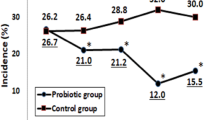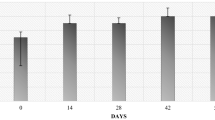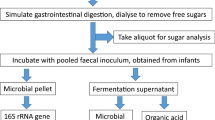Abstract
Background/objectives:
To examine the bacteriological quality of complementary foods (CF) and to correlate the results with diarrhoeal morbidity and nutritional status of Bangladeshi children aged 6–24 months.
Subjects/methods:
A total of 212 CF samples were tested, of which 72 were collected immediately before the first time of feeding (⩽1 h of food preparation) and 140 were collected at second/third time of feeding from 140 households located in urban and rural areas of Bangladesh. Anthropometry, food frequency data and demographic information of the children were collected.
Results:
Of the first time feeding samples, 3% from each of urban and rural areas were found to be contaminated with faecal coliforms (FC) at ⩾100 CFU/g. E. coli was isolated from 11% and 6% of samples, and B. cereus from 8% and 6% of samples from urban and rural areas, respectively. In contrast, 33% of the second/third time feeding samples from urban areas and 19% from rural areas were contaminated with FC at ⩾100 CFU/g (P<0.05). E. coli was isolated from 40% and 39% of samples, and B. cereus from 33% and 26% of samples from urban and rural areas, respectively. Significantly high numbers of wasted rural children had CF with a high aerobic plate count, which was also significantly associated with diarrhoeal morbidity in children.
Conclusions:
Around 40% of CF samples were contaminated with E. coli, which was mainly attributable to food preparation practices. Consumption of contaminated CF appeared to be associated with a higher frequency of diarrhoea and malnutrition in children.
This is a preview of subscription content, access via your institution
Access options
Subscribe to this journal
Receive 12 print issues and online access
$259.00 per year
only $21.58 per issue
Buy this article
- Purchase on Springer Link
- Instant access to full article PDF
Prices may be subject to local taxes which are calculated during checkout
Similar content being viewed by others
References
You D, Wardlaw T, Salama P, Jones G . Levels and trends in under-5 mortality, 1990-2008. Lancet 2010; 375: 100–103.
Black RE, Morris SS, Bryce J . Where and why are 10 million children dying every year? Lancet 2003; 361: 2226–2234.
Baqui AH, Ahmed T . Diarrhoea and malnutrition in children. BMJ 2006; 332: 378.
WHO Pan American Health Organization (PAHO). Guiding principles for complementary feeding of the breastfed child. World Health Organization: Geneva, 2001 pp 40.
World Health Organization (WHO). Complementary feeding of young children in developing countries: a review of current scientific knowledge. World Health Organization: Geneva, 1998 pp 227.
Kimmons JE, Dewey KG, Haque E, Chakraborty J, Osendarp SJ, Brown KH . Low nutrient intakes among infants in rural Bangladesh are attributable to low intake and micronutrient density of complementary foods. J Nutr 2005; 135: 444–451.
Dewey KG, Brown KH . Update on technical issues concerning complementary feeding of young children in developing countries and implications for intervention programs. Food Nutr Bull 2003; 24: 5–28.
Hotz C, Gibson RS . Complementary feeding practices and dietary intakes from complementary foods amongst weanlings in rural Malawi. Eur J Clin Nutr 2001; 55: 841–849.
Motarjemi Y, Kaferstein F, Moy G, Quevedo F . Contaminated weaning food: a major risk factor for diarrhoea and associated malnutrition. Facts Infant Feed 1993; 71: 79–92.
Sheth M, Dwivedi R . Complementary foods associated diarrhoea. Indian J Pediatr 2006; 73: 61–64.
Lanata CF . Studies of food hygiene and diarrhoeal disease. Int J Environ Health Res 2003; 13: S175–S183.
Brown KH, Black RE, Lopez de Romana G, Creed de Kanashiro H . Infant-feeding practices and their relationship with diarrhoeal and other diseases in Huascar (Lima), Peru. Pediatrics 1989; 83: 31–40.
Mosha TCE, Laswai HS, Tetens I . Nutritional composition and micronutrient status of homemade and commercial weaning foods consumed in Tanzania. Plant Foods Hum Nutr (Dordrecht, Netherlands) 2000; 55: 185–205.
Anthro WHO. 2005 beta version Feb 17th, 2006: Software for assessing growth and development of the world's children. World Health Organization: Geneva, 2000 Available from http://www.who.int/childgrowth/software/en/.
National Institute of Population Research and Training (NIPORT), Mitra and Associates, Bangladesh Demographic and Health Survey 2007: National Institute of Population Research and Training, Mitra and Associates, Macro International Inc: Dhaka, Bangladesh, Calverton, MD, USA, 2009.
Islam MA, Heuvelink AE, Talukder KA, Zwietering MH, de Boer E . Evaluation of immunomagnetic separation and PCR for the detection of Escherichia coli O157 in animal feces and meats. J Food Prot 2006; 69: 2865–2869.
Islam MA, Heuvelink AE, de Boer E, Sturm PD, Beumer RR, Zwietering MH . Shiga toxin-producing Escherichia coli isolated from patients with diarrhoea in Bangladesh. J Med Microbiol 2007; 56: 380–385.
Frankel G, Giron JA, Valmassoi J, Schoolnik GK . Multi-gene amplification: simultaneous detection of three virulence genes in diarrhoeal stool. Mol Microbiol 1989; 3: 1729–1734.
Lüscher D, Altwegg M . Detection of shigellae, enteroinvasive and enterotoxigenic Escherichia coli using the polymerase chain reaction (PCR) in patients returning from tropical countries. Mol Cell Probes 1994; 8: 285–290.
Kung'u JK, Boor KJ, Ame SM, Ali NS, Jackson AE, Stoltzfus RJ . Bacterial populations in complementary foods and drinking-water in households with children aged 10-15 months in Zanzibar, Tanzania. J Health Popul Nutr 2009; 27: 41–52.
Acknowledgements
This research was funded by the Food and Agriculture Organization of the United Nations (Grant number PR 42551). International Centre for Diarrhoeal Diseases Research, Bangladesh (ICDDR, b) acknowledges with gratitude the commitment of the Food and Agriculture Organization of the United Nations to its research efforts. ICDDR, b also gratefully acknowledges the following donors, which provide unrestricted support: Australian Agency for International Development (AusAID), Government of the People’s Republic of Bangladesh, Canadian International Development Agency (CIDA), Swedish International Development Cooperation Agency (Sida), and the Department for International Development, UK (DFID).
Author information
Authors and Affiliations
Corresponding author
Ethics declarations
Competing interests
The authors declare no conflict of interest.
Rights and permissions
About this article
Cite this article
Islam, M., Ahmed, T., Faruque, A. et al. Microbiological quality of complementary foods and its association with diarrhoeal morbidity and nutritional status of Bangladeshi children. Eur J Clin Nutr 66, 1242–1246 (2012). https://doi.org/10.1038/ejcn.2012.94
Received:
Revised:
Accepted:
Published:
Issue Date:
DOI: https://doi.org/10.1038/ejcn.2012.94
Keywords
This article is cited by
-
Bacteriological quality and safety of bottle food and associated factors among bottle-fed babies attending pediatric outpatient clinics of Government Health Institutions in Arba Minch, southern Ethiopia
Journal of Health, Population and Nutrition (2023)
-
Design, delivery, and determinants of uptake: findings from a food hygiene behavior change intervention in rural Bangladesh
BMC Public Health (2022)
-
Fecal indicator bacteria along multiple environmental exposure pathways (water, food, and soil) and intestinal parasites among children in the rural northwest Ethiopia
BMC Gastroenterology (2022)
-
Provision versus promotion to develop a handwashing station: the effect on desired handwashing behavior
BMC Public Health (2017)
-
Where food safety meets nutrition outcomes in livestock and fish value chains: a conceptual approach
Food Security (2017)



